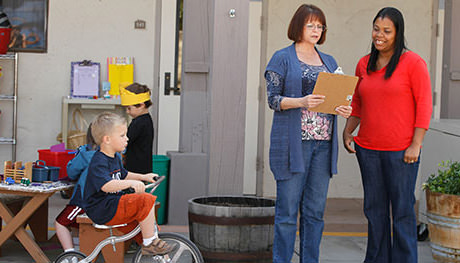Action is the test of what you know and can do. It is where you see the results of reflection and self-assessment. The CompSAT protocol, Keys to Reflection and Inquiry, is designed to help you formulate good questions, pursue inquiry, and take action to improve your daily practice. The results of your actions provide evidence of your professional growth, and hopefully, spur you on to generate more questions and take further action. Action and reflection are essential to the processes of growth and change.

If you're wondering how to allow more risk-taking in your environment, consider what Adriana, a family childcare provider, has done.
Adriana has hung a rope from a tree in her backyard. To enable children of all developmental levels to access it, she has put some climbing blocks right next to the tree. As she watches, she decides which children will need support from her, and which are ready to have a go on their own.
Consider how you might add an element of risk — a new play opportunity, activity, or structure into your environment that will challenge children's abilities and offer them ways to test their skills. Write down your ideas.
Carefully plan how you will introduce a new play opportunity, activity, or structure to the children.
Regularly observe and record the details of how different children approach the activity or structure. Study your documentation for more insights into individual children and new possibilities for your environment.
Record your reflections.
In the opening video for this competency, you were introduced to the idea of "untiming the curriculum." Reading about this teacher research project could inspire you to see what would happen in your own setting if you took your watches and clocks away.
Remembering that research suggests children don't engage in the deeper complex play of learning until they are engaged for at least 40 minutes, assess whether you are interrupting children's learning by segmenting your schedule into small blocks of time. Try this approach to assessing the children's experience of your schedule.
Write down your daily schedule, including the times, routines, and activities you follow with the children. Then, assign one of three colors to each of the following categories. Use them to color-code your schedule as follows:
Now, add up the total time allocated for each of these colors. What does this information tell you? Adapted from Curtis and Carter, Learning Together with Young Children (2008).
Consider what changes you could make in your schedule to provide a more enriching social environment for children's play and learning? Discuss these ideas with your colleagues. Together, devise a plan to put your ideas into action.
Use this template to record your observations, thoughts, and feelings. Download the Template
Deepen your understanding by reviewing the Topic: Schedules and daily routines in Performance Area 2 of the competency Learning Environments and Curriculum in the CA ECE Competencies. Scroll to page 73.
Can you find other places in this competency area that address your interests and needs?
